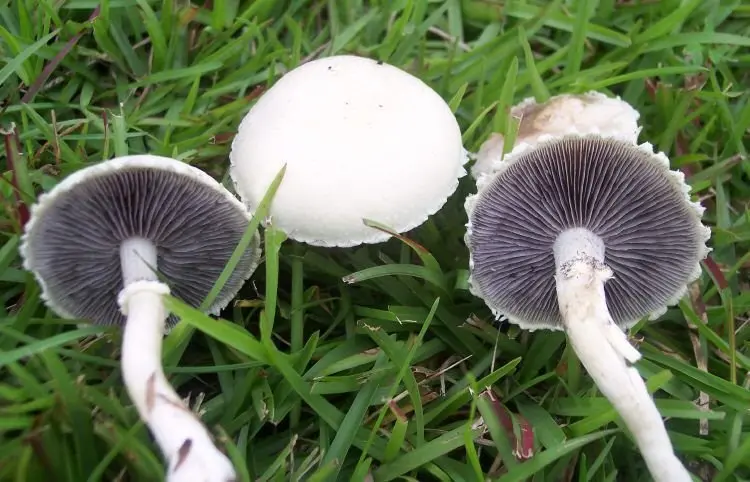Stropharia melanosperma (Stropharia melanosperma)
- Division: Basidiomycota (Basidiomycetes)
- Subdivision: Agaricomycotina (Agaricomycetes)
- Class: Agaricomycetes (Agaricomycetes)
- Subclass: Agaricomycetidae (Agaricomycetes)
- Order: Agaricales (Agaric or Lamellar)
- Family: Strophariaceae (Strophariaceae)
- Genus: Stropharia (Stropharia)
- Type: Stropharia melanosperma (Stropharia black-spore)
- Stropharia chernosemyannaya

Hat:
In young mushrooms, the cap has a cushion shape. With age, the cap opens and becomes almost completely prostrate. The hat is 2-8 cm in diameter. The surface of the hat has all shades of yellow, from light yellow to lemon. It is unevenly colored, whitish along the edges. Mature mushrooms have a faded hat. Sometimes flaky remnants of the bedspread are visible along the edges of the cap. In wet weather, the cap is oily and smooth.
Pulp:
thick, quite soft, light. At the break, the flesh does not change color. It has an unusual sweet smell.
Records:
of medium width and frequency, grown with the edges of the cap and stem. If you carefully cut off the leg, then the lower surface of the cap becomes absolutely flat. In young mushrooms, the plates have a grayish color, then they become dark gray from ripe spores.
Spore Powder:
purple-brown or dark purple.
Leg:
Black spore stropharia has a white stem. Up to ten centimeters long, up to 1 cm thick. The lower part of the leg is covered with small whitish-gray flakes. At the base may thicken slightly. On the leg there is a small, neat ring. Highly located in the upper part of the ring, at first white, it darkens later from ripening spores. The surface of the leg may turn yellow in small spots. Inside the leg is first solid, then becomes hollow.
According to some sources, Stropharia chernospore bears fruit from the beginning of summer until an unknown time. The fungus is not very common. It grows in gardens, fields, meadows and pastures, sometimes found in forests. Prefers manure and sandy soils. Grows singly or in small groups. In a splice of two or three mushrooms.
Black-spore stropharia resembles coppice or thin champignon. But, quite a bit, since the shape and color of the Stropharia plates, as well as the color of the spore powder, make it possible to quickly discard the version with Mushrooms. The same can be said about the white subspecies of the Early Polevik.
Some sources claim that Stropharia chernospore is an edible or conditionally edible mushroom. One thing is for sure, it is definitely not poisonous or hallucinogenic. True, it is not at all clear why this mushroom should be grown then.
This porcini mushroom strongly resembles champignons, but when boiled, the Stropharia plates lose their pigment, which is also its feature and difference.









